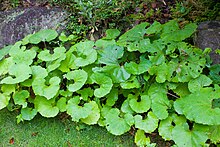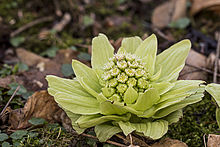Fuki
| Giant butterbur | |
|---|---|
 |
|
| Adult fuki | |
 |
|
| Fuki shoot | |
| Scientific classification | |
| Kingdom: | Plantae |
| (unranked): | Angiosperms |
| (unranked): | Eudicots |
| (unranked): | Asterids |
| Order: | Asterales |
| Family: | Asteraceae |
| Genus: | Petasites |
| Species: | P. japonicus |
| Binomial name | |
|
Petasites japonicus (Siebold & Zucc.) Maxim. |
|
| Nutritional value per 100 g (3.5 oz) | |
|---|---|
| Energy | 59 kJ (14 kcal) |
|
3.61 g
|
|
|
0.04 g
|
|
|
0.39 g
|
|
| Vitamins | |
| Thiamine (B1) |
(2%)
0.02 mg |
| Riboflavin (B2) |
(2%)
0.02 mg |
| Niacin (B3) |
(1%)
0.2 mg |
| Pantothenic acid (B5) |
(1%)
0.032 mg |
| Vitamin B6 |
(7%)
0.096 mg |
| Folate (B9) |
(3%)
10 μg |
| Vitamin C |
(38%)
31.5 mg |
| Minerals | |
| Calcium |
(10%)
103 mg |
| Iron |
(1%)
0.1 mg |
| Magnesium |
(4%)
13 mg |
| Manganese |
(13%)
0.274 mg |
| Phosphorus |
(2%)
12 mg |
| Potassium |
(14%)
655 mg |
| Sodium |
(0%)
7 mg |
| Zinc |
(2%)
0.16 mg |
|
|
|
|
|
| Percentages are roughly approximated using US recommendations for adults. Source: USDA Nutrient Database |
|
Petasites japonicus, also known as fuki (フキ(蕗、苳、款冬、菜蕗)?), bog rhubarb, Japanese sweet coltsfoot or giant butterbur, is an herbaceous perennial plant in the family Asteraceae. It exists in China, Japan, Korea and Sakhalin. But also exists many places in Europe, too. It is especially commonly found around Swiss alps. It has also been introduced to southern British Columbia by Japanese immigrants.
The traditional preparation method for this vegetable involves pre-treating with ash or baking soda and soaking in water to remove harshness (astringency), which is a technique known as aku-nuki (灰汁抜き?, literally "harshness removal"). The shoot can be chopped and stir fried with miso to make Fuki-miso which is eaten as a relish thinly spread over hot rice at meals. The bulb-like shoots are also picked fresh and fried as tempura. In Korea, it is steamed or boiled and then pressed to remove water. Sesame oil or perilla oil is added in order to make namul.
Like other Petasites species, fuki contains pyrrolizidine alkaloids (PAs) which have been associated with cumulative damage to the liver and tumor formation. It also contains the carcinogenic PA petasitenine. The concentration of hepatotoxic PAs can be reduced to a concentration below detection limits with a proper extraction process. Since many alkaloids are bitter, traditional methods of preparation may have evolved to remove them.
...
Wikipedia
